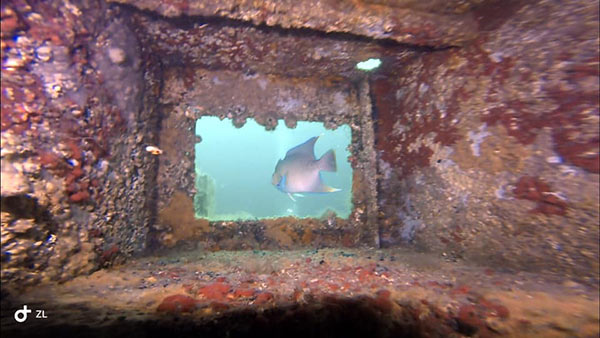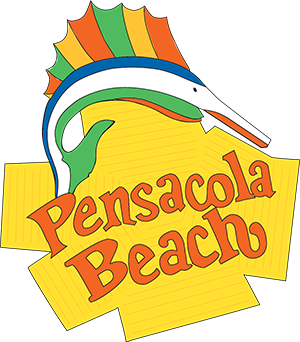Dive Into Pensacola Beach
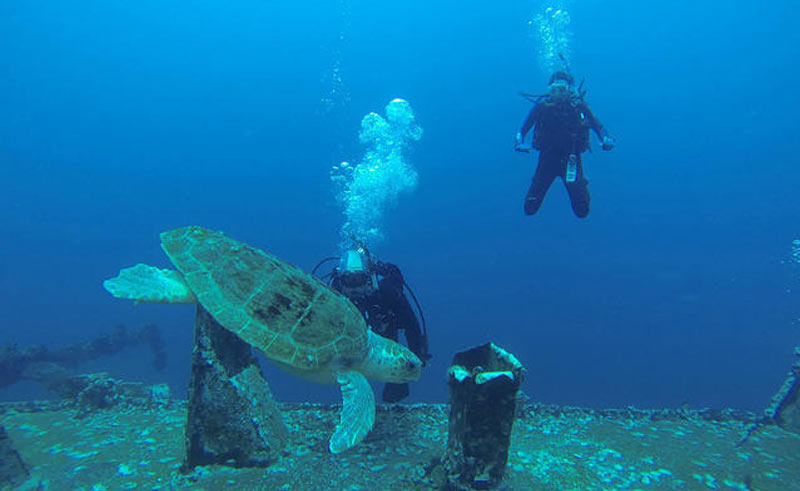
By Katie King
Your complete guide to underwater exploration
The coastline of Pensacola Beach has been luring scuba divers and snorkelers here for decades. The pristine Gulf waters around Pensacola Beach are home to dozens of ghostly shipwrecks and underwater structures — teeming with sea life and begging to be explored by scuba divers or snorkelers.
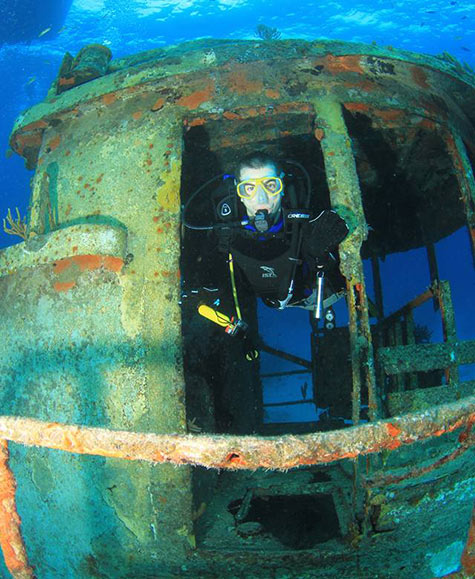 Five of those shipwrecks lie just a short boat ride from the Pensacola Pass and are part of the Florida Panhandle Shipwreck Trail – a bucket list of 12 explorable shipwrecks from Pensacola to Port St. Joe, FL. It’s quite an incredible experience, seeing stately vessels absorbed into the Gulf habitat. Powerful amberjack, grouper and snapper call these wrecks home, inviting divers of different skills.
Five of those shipwrecks lie just a short boat ride from the Pensacola Pass and are part of the Florida Panhandle Shipwreck Trail – a bucket list of 12 explorable shipwrecks from Pensacola to Port St. Joe, FL. It’s quite an incredible experience, seeing stately vessels absorbed into the Gulf habitat. Powerful amberjack, grouper and snapper call these wrecks home, inviting divers of different skills.
Here are a few to put on your list to experience:
The Great Carrier Reef
The world really took notice of Pensacola Beach’s dive scene in 2006 when an 872-foot aircraft carrier, the USS Oriskany, took her final voyage over the Gulf of Mexico to become the world’s largest artificial reef — about 25 miles south of Pensacola Beach.
Sailors called the USS Oriskany “The Mighty O” when she served in both the Korean and Vietnam Wars. Senator John McCain was a naval aviator flying an A-4 from her decks during the Vietnam War, and flew his fateful mission from the Oriskany when he was shot down over North Vietnam and captured.
Today, The Mighty O is making natural history as The Great Carrier Reef, the flagship of the Panhandle Shipwreck Trail. As you descend below 85 feet, the tall shape of a smokestack appears out of the blue, circled by squadrons of amberjack. Slowly, the superstructure and massive hulk of the aircraft carrier appears. Welcome to the final resting place of the Mighty O.
The Oriskany sits upright on the bottom in 220 feet of water, the bottom is well beyond the depth for recreational divers, but its tower reaches up to about 84 feet below the surface. The island superstructure, including the bridges, are above the recreational diving limit of 130 feet. Technical divers can land on the flight deck at 145 feet, and the cavernous Hangar Bay beckons at 175 feet.
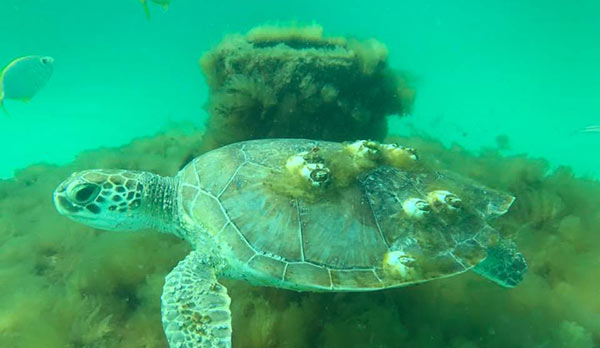
Joe Patti Reef
In July of 2013 the Joe Patti Reef was deployed in approximately 50 feet of water just three miles east of the Pensacola Pass on Pensacola Beach. The reef, a 175 x 80-foot barge covered in artwork depicting famous Pensacola landmarks and businesses like the iconic Pensacola Beach marlin sign, the Joe Patti’s logo sign, the Blue Angels flying in diamond formation, the Casino Beach Ball, and more, is considered an underwater art gallery. Artist Kevin Marchetti created 120 stainless steel memorials and sculptures, some of which contain the ashes of loved ones. The wreck even has a mock Flora-Bama bar with bar stools and colorful beer mugs welcoming divers to take a break.
The San Pablo
Another mysterious ship has wowed divers for decades. The San Pablo, also called “the Russian Freighter,” once hauled fruit until it was sunk by a U-Boat near Central America. It was re-floated, only to be sunk again off Pensacola Beach in 1944 — by the U.S. as part of a top-secret weapons test. A radio-controlled boat packed with 3,000 pounds of explosives scattered the San Pablo across the seafloor. Today, divers can explore boilers, refrigeration coils, and huge sections of twisted metal, all home to an impressive array of marine life.
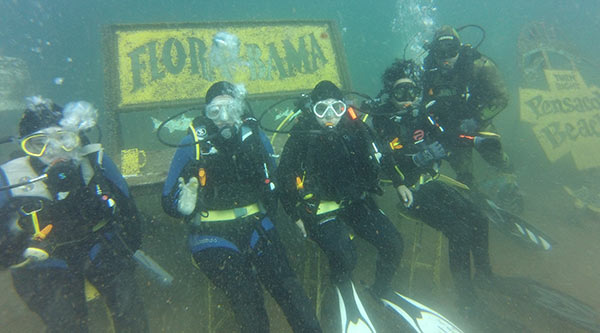
Pete Tide II
Even a lowly supply boat makes a magnificent sight on the seafloor. Sunk in 1993, the Pete Tide II looks like it’s ready to set sail. It stands eerily upright from 100 to 60 feet of water, luring divers to explore the bridge. Three runaway coal barges scuttled during an emergency in 1974 are home to sea life at 50 feet — a favorite for divers to hone their skills.
USS Massachusetts
Considered the oldest battleship still in existence, the USS Massachusetts has spent the past 97 years rusting at the mouth of Pensacola Bay. In 1920, the retired battleship served as target practice from the battery at Fort Pickens. After weeks of cannon fire, she finally sank in 26 feet of water.
Now an Underwater Archaeological Preserve managed by the state of Florida – the USS Massachusetts takes you back in time more than a century. Her wreckage is a popular shallow diving spot as it is well lit by the sun and swarming with marine life, but it is possible to snorkel the Massachusetts at times, as the top of her wheelhouse still breaks the surface at low tide.
IMPORTANT: When diving or snorkeling the Mass, caution is advised. Because of her location in the pass, the current rips through her wreckage at a high velocity, except during slack tide. Arrive at the tail end of high tide, and prepare to dive in the slack hour or two before the water starts rushing back out of the pass.
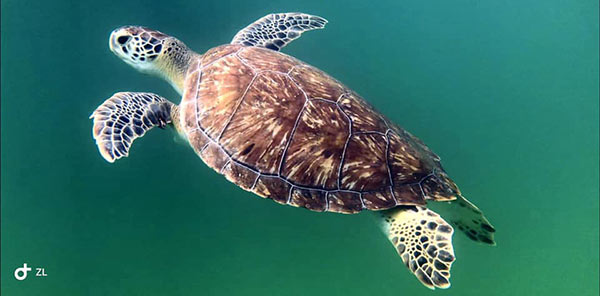
Snorkelers Find Underwater Heaven Too
You don’t need a boat to enjoy the underwater world. Three snorkeling reefs have been created for the public on Pensacola Beach:
- Park EastSnorkel Reef lets you take a paddleboard or kayak with your snorkeling gear and dive. It’s located 1.4 miles east of Portofino Island Resort on the Gulf side — about 500 feet offshore.
- Casino Beach Snorkel Reef is a man-made artificial reef, about 150 feet long by 30 feet wide, about 500 feet offshore just east of the Pensacola Beach Fishing Pier in about 15-foot-depth.
- Pensacola Bay Snorkel Reef (aka Park West Snorkel Reef) offers the chance to explore a large, offshore artificial reef in the 7-to-10-foot protected waters near the Fort Pickens gate.
